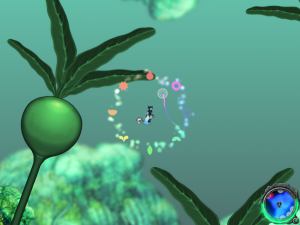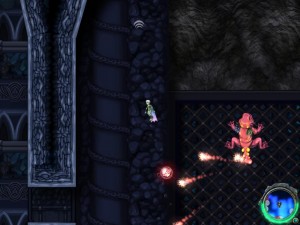Aquaria: More Songs
 My last session netted me two more songs for transforming — apparently this is what most of the songs do. First off was fish form, which turns you into a small fish with an oddly human face.
My last session netted me two more songs for transforming — apparently this is what most of the songs do. First off was fish form, which turns you into a small fish with an oddly human face.
I should note something about the faces in this game generally. Most of the creatures are fish, which of course don’t have much in the way of facial expressions, but Naija and a few other beings seen in visions are humanoid. Humanoid figures are articulated like an Indonesian shadow puppet, all 2D and shown permanently in profile but with rotating joints. This gives them enough freedom of movement that, when the camera is zoomed in enough for you to see faces clearly (as happens when you stay still for a while), it feels a little weird that the faces are so immobile. It reminds me a little of Jason Little’s experimental comic Jack’s Luck Runs Out, which uses faces from a deck of playing cards for all its characters. Little described the result as a “masked drama”, because of the way he had to compensate for the inexpressive faces with expressive body language. At any rate, it’s a bit of a reminder of what this game really is: not a world, but a work of art.
The purpose of fish form is to fit yourself through narrow passages. Supposedly it also makes some enemies ignore you, but my first try at using it in that way was unsuccessful enough to scare me away from further attempts. Once I had it, I of course started going back to places where I had noticed narrow passages before, and in the process found a boss fight against an enormous face, which occasionally changed expression. When it did, it became vulnerable to attack, allowing you to punish it for such inappropriate behavior.
The reward for destroying the unnaturally variable face: a new song. Apparently the face was the source of power for a now-extinct race of aquatic druids, and now I can turn into an approximation of one of them. (Because obviously you need to make yourself as powerful as beings who failed to prevent the extinction of their own race. I guess it’s better than fish form, at least.) In this form, you throw seeds that grow into huge and damaging thorn plants when they hit a solid surface. It’s not a very effective form of combat against most creatures; there are some things that crawl along the walls, or land on the walls between leaps, or even just stay in one place all the time, but these are generally the things it’s easy to get away from by just swimming away from the wall. I suppose I’ll find places where it’s tactically indespensible — that seems to be how things generally work in this game — but for now, my main use for it is to get past barriers. There are blue bubble-like barriers on certain passages, invulnerable to fireballs but poppable by thorns. This seems extremely arbitrary, but the game seems to have a rule that any new song you learn has to have a unique kind of barrier it overcomes.
 Comments(0)
Comments(0)
